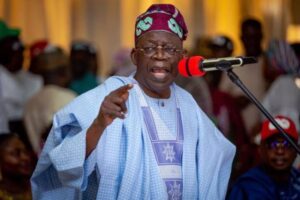Physical Address
304 North Cardinal St.
Dorchester Center, MA 02124
Physical Address
304 North Cardinal St.
Dorchester Center, MA 02124

Say It As It Is

Say It As It Is

Recounting an ordeal, a friend of mine retired in 2010 as a Director on GL.17 and a senior one at that, after 35 years or maybe the 8-year tenure from the Federal Public Service (FPS).
That was a few years after the 2004 pension reform that ushered in the Contributory Pension Scheme (CPS). The scheme’s Act was reviewed and renacted in 2014 to expand its scope and depth.
My good friend was made to understand that the new scheme/programme was a contributory one that was fed from two saving streams; the employer’s and employee’s contributions saved throughout an individual’s career, in a given proportion.
This proportionate statutory contribution was 8% and 10% of the employee monthly salary by himself and employer, respectively.
The total savings so accrued would then be transferred to government-acredited private entities called Pension Fund Administrators (PFAs) by the National Pension Commission (PenCom).
At the PFA and on the direction of the overall national regulatory agency, the Pension Commission (PenCom), the total savings by the retiring employee was appropriated into two largely unequal parts based on a given formula.The first part was called the “lump sum” that was paid to the employee at the point of exit, while the other became the “stock” of the retiree’s savings, which was kept in what is now referred to as the Retiree Savings Account (RSA).
How much lump sum an employee got depended on individual PFA’s interpretation, initially.
However, with time, it was made clear that the ratio wasn’t 50:50 as previously understood.
The correct interpretation of the policy as it were, was to set aside 50% of the individual retiree’s basic pay while in service, then multiply it by 12 months (1 year) and projected to somewhere in the region of 10-15 years or thereabout.
The amount so arrived at, thus, became his friend’s pension stock from where he draws his monthly due. It was the balance left, usually between 30-40% of the total career savings that was paid out as his lump sum.
As a GL 17 officer, the average total contribution stands between N19m to N22 million. The basic salary of Directors as of 2013 was N250,000 (net), and 50% of it was used in the computation of the mandatory monthly pension, which comes to N125,000, or even less in some cases. This has been the lot of Directors that retired under the Contributory Pension Scheme. The various cadres of retirees at the State and LGA levels follow a similar pattern.
Conceptually, the CPS policy was a well thought out policy with a view to streamlining the challenges of Pension Administration in Nigeria since independence. However, about a decade down the line, the scheme seems to be facing existential challenges of both disparities and distortions.
The envisaged equity in the scheme has been jettisoned making possible the manifestation of two classes of federal pensioners; those well paid from the government favoured establishments and the others, who retired from “ordinary” MDAs including the Diplomatic Services. So apart, in terms of quality of life, that one is tempted to think that the groups served under two different nations.
The equivalent of a Director in the civil and/or public service in the Military, the Police, Security Services are believed to earn nearly three to five times the N125,000 per month pension of the said uniformed service class. Similar or greater disparities obtains between the regular retiree and his counterparts from such government establishments as NNPC, CBN, FIRS, RMAFC, NPA, BoI, BPE, NCC, NIMASA etc.The question was, if the uniformed Services entail greater risks and the possibility of paying the supreme price, same cannot be said of the other agencies. Nor, of the disparity between the Director cadre and the Permanent Secretary position as the latter usually rises from the former.
A section of government had advanced justifications for the humongous disparities between the pension of the core civil servants and their counterparts from the mentioned organisations. They include such assertion as being “revenue generating” agencies and the need to incentify their operations so as to insulate functionaries from corruption. The reality has proved the very opposite.
Today, these agencies have become cesspool of corruption and a distortion to the national economy. The nation looses billions, if not trillions, through many of their unholy operations. The improved welfare accorded some of these organisations only served to sharpen their corruptive tendencies. A great continuous drawback for national development. Besides, in matters of national development, all agencies and individuals count “revenue” generating or not. Neither could succeed without the other, though this should not negate the provision of deserving incentives as applicable.
The need for such incentives should however not be stretched to the ridiculous extent of paying one set of federal staff/pensioners less than 1/5 or thereabout of the other as seen in case of the uniformed Services and the bandied revenue generating establishments. Really, one wonders how working in revenue generating or any class of MDAs places individuals at so much disadvantage that they needed to be “compensated” (salary and pension packages) four to five folds over and above their counterparts. It’s like saying a human resources officer working in the NNPC Towers experiences greater inconveniences than his colleague at the Federal Secretariat from the perspectives of an empirically evaluated job content and the working environment.
As for the Military and allied services, it would seem, the government simply “adopted” which provides that “someone who retires at 20 years will receive 50% of their base salary as a pension, but each additional year they stay in, they will receive a multiplier of 2.5% more towards their retirement. If they make it to 40 years, they will receive their full salary as pension. “Great as this is, especially when accompanied by hiked (sometimes by executive fiat) salary structure, the approach as a whole represents a serious distortion on a struggling economy and also out of sync with plight the larger body of pensioners struggling to survive in a nation with no credible social safety nets. Unfortunately, many agencies are currently pushing in that same economically distructive direction. Unfortunately, this development is just a part of the Nigerian Pension story. The other is the operations of the PFAs
Pensioners, even with the meagre monthly withdrawals, have to contend with the opaque handling of their funds (RSA) by the PFAs. The PFAs, some of which have undergone series of mergers and acquisitions, are believed to be investing the retiree savings in income yielding portfolios such as government bonds, treasuries and other facilities.
The rate of returns on such investments are hardly known but for sure are handsome because to date, many people are being paid from only the yield (interest) acruing from the RSA, leaving the initial fund intact. This is besides the “classy” standard of environments in which the PFAs operate, plus the “huge perks” both the executive and non executive cadres enjoy. Pensioners need to know how much the PFAs are taking from the returns on their invested savings. And how equitable too.
They should also be allowed the opportunity to undertake such investments on their own if it would pay them better. For now, it is obvious that the average pensioner in Nigeria is caught up between the deep blue sea (government-induced disparities) and a hard rock (the PFAs) , many of whom have become destitutes.
As a way forward, the government should consider the following as a matter of urgency;
1. Review the New Pension Scheme after more than a decade in existence
2. Disparities among the public service pensioners should be harmonised so as to strike an equitable, if not moral balance. The 1:4 pension pay ratio or thereabout stinks.
3. The PFAs should be compelled to let pensioners know the returns on their RSA fund.
4. The government should look into the possibility of facilitating individual pensioners, who desire to invest his savings on his own to do so under guidance.
5. It is also high time for the government to articulate and/or operationalise a robust “Senior Citizens Policy” in recognition of their contributions to nation building and to also enhance their well-being in line with best global practices and local African traditions.
The Nigerian pensioners should be treated within the context of the universal creed as espoused by the USA to the effect that all men are created equal, that they are endowed by their Creator with certain unalienable rights, that among these are descent (sic) life, liberty and the pursuit of happiness”.
After all, Nigeria copied the scheme from the USA.
This piece was written by A. G. Abubakar- *agbarewa@gmail.com* and Edited by Goodluck B Ikiebe.